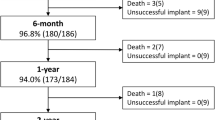Abstract
Most occurrences of large patent ductus arteriosus (PDAs) of ≥10 mm have been surgically closed, and transcatheter closure of these large PDAs was only reported in a few case reports. The present study reviewed our experience in transcatheter closure of such large PDAs with a Chinese self-expandable occluder, which is similar to but much cheaper than the Amplatzer occluder. From July 2000 to January 2008, 23 patients underwent transcatheter closure of large PDA ≥10 mm with this kind of occluder. The mean (SD) age of the patients was 38.0 (15.6) years (range 18–75 years). Radiographs of the chest, electrocardiograms, and echocardiograms were used for follow-up evaluation of the treatment within 1 day, 1 month, 6 months, and then every year after successful closure. The mean (SD) angiographic PDA diameter was 12.8 (2.6) mm (range 10–18 mm) and the mean occluder diameter was 18.0 (2.9) mm (range 16–22 mm). The occluders were delivered successfully and closed the PDA completely in 19 out of the 23 patients. Pulmonary arterial pressures decreased significantly after occlusion in patients with successful treatment: 67.3 (24.7) mmHg (range 29–122 mmHg) before occlusion and 42.3 (22.0) mmHg (range 19–98 mmHg) immediately after the procedure. Radiographs of the chest and echocardiograms showed that the diameters of the left atrium, left ventricle, and the main pulmonary artery decreased, and the ejection fraction (EF) increased at a mean (SD) follow-up of 36.3 (18.7) months (range 6–72 months). No severe complication occurred. The immediate and long-term outcomes suggested that transcatheter closure of PDAs with the native PDA occluder is a safe and effective treatment for adults with large PDA ≥10 mm.
Similar content being viewed by others
References
Chien KJ, Lee CL, Huang TC, Lin CC, Weng KP, Huang SH, Hsieh KS (2007) A noninvasive sizing method to choose fitted Amplatzer septal occluder by transthoracic echocardiography in patients with secundum atrial septal defects. Heart Vessels 22:245–250
Huang TC, Hsieh KS, Lin CC, Lee CL (2008) Clinical results of percutaneous closure of large secundum atrial septal defects in children using the Amplatzer septal occluder. Heart Vessels 23:187–192
Hosking MCK, Benson LN, Musewe N, Dyck JD, Freedom RM (1991) Transcatheter occlusion of the persistently patent ductus arteriosus: forty-month follow-up and prevalence of residual shunting. Circulation 84:2313–2317
Thanopoulos BD, Hakim FA, Hiari A, Goussous Y, Basta E, Zarayelyan AA, Tsaousis GS (2000) Further experience with transcatheter closure of the patent ductus arteriosus using the Amplatzer duct occluder. J Am Coll Cardiol 35:1016–1021
Bilkis AA, Alwi M, Hasri S, Haifa AL, Geetha K, Rehman MA, Hasanah I (2001) The Amplatzer duct occluder: experience in 209 patients. J Am Coll Cardiol 37:258–261
Moore JW, Levi DS, Moore SD, Schneider DJ, Berdjis F (2005) Interventional treatment of patent ductus arteriosus. Catheter Cardiovasc Interv 64:91–101
Ewert P (2005) Challenges encountered during closure of patent ductus arteriosus. Pediatr Cardiol 26:224–229
Yan C, Zhao S, Jiang S, Xu Z, Huang L, Zheng H, Ling J, Wang C, Wu W, Hu H, Zhang G, Ye Z, Wang H (2007) Transcatheter closure of patent ductus arteriosus with severe pulmonary arterial hypertension in adults. Heart 93:514–518
Pass RH, Hijazi Z, Hsu DH, Lewis V, Hellenbrand WE (2004) Multicenter USA Amplatzer patent ductus arteriosus occlusion device trial: initial and one-year results. J Am Coll Cardiol 44:513–9
Masura J, Walsh KP, Thanopoulos B, Chan C, Bass J, Goussous Y, Gavora P, Hijazi ZM (1998) Catheter closure of moderate-to large-sized patent ductus arteriosus using the new Amplatzer Duct Occluder: immediate and short-term results. J Am Coll Cardiol 31:878–882
Krichenko A, Benson LN, Burrows P, Moes CAF, McLaughlin P, Freedom RM (1989) Angiographic classification of the isolated, persistently patent ductus arteriosus and implications for percutaneous transcatheter occlusion. Am J Cardiol 67:877–880
Gross RE, Hubbard JP (1939) Surgical ligation of a patent ductus arteriosus. JAMA 112:729–731
Mavroudis C, Backer CL, Gevitz M (1994) Forty-six years of patent ductus arteriosus division at Children’s Memorial Hospital of Chicago: standards for comparison. Ann Surg 220:402–409
Author information
Authors and Affiliations
Corresponding author
Rights and permissions
About this article
Cite this article
Yu, Ml., Huang, Xm., Wang, Jf. et al. Safety and efficacy of transcatheter closure of large patent ductus arteriosus in adults with a self-expandable occluder. Heart Vessels 24, 440–445 (2009). https://doi.org/10.1007/s00380-009-1150-5
Received:
Accepted:
Published:
Issue Date:
DOI: https://doi.org/10.1007/s00380-009-1150-5




